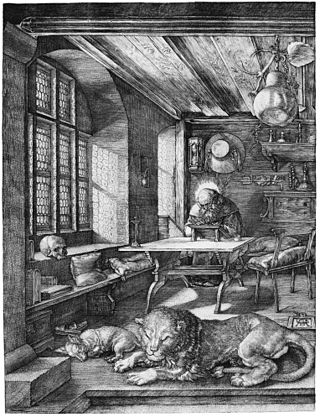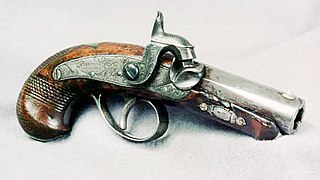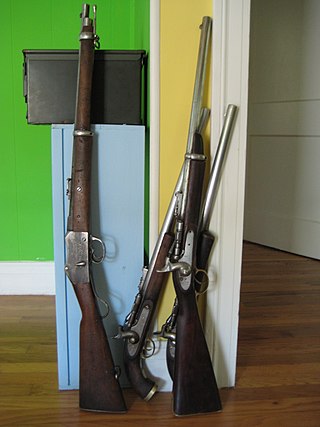Related Research Articles
Gun laws and policies, collectively referred to as firearms regulation or gun control, regulate the manufacture, sale, transfer, possession, modification, and use of small arms by civilians. Laws of some countries may afford civilians a right to keep and bear arms, and have more liberal gun laws than neighboring jurisdictions. Countries that regulate access to firearms will typically restrict access to certain categories of firearms and then restrict the categories of persons who may be granted a license for access to such firearms. There may be separate licenses for hunting, sport shooting, self-defense, collecting, and concealed carry, with different sets of requirements, permissions, and responsibilities.

Engraving is the practice of incising a design onto a hard, usually flat surface by cutting grooves into it with a burin. The result may be a decorated object in itself, as when silver, gold, steel, or glass are engraved, or may provide an intaglio printing plate, of copper or another metal, for printing images on paper as prints or illustrations; these images are also called "engravings". Engraving is one of the oldest and most important techniques in printmaking.

Rifling is the term for helical grooves machined into the internal surface of a firearms's barrel for imparting a spin to a projectile to improve its aerodynamic stability and accuracy. It is also the term for creating such grooves.

Samuel Colt was an American inventor, industrialist, and businessman who established Colt's Patent Fire-Arms Manufacturing Company and made the mass production of revolvers commercially viable.

The National Firearms Act (NFA), 73rd Congress, Sess. 2, ch. 757, 48 Stat. 1236 was enacted on June 26, 1934, and currently codified and amended as I.R.C. ch. 53. The law is an Act of Congress in the United States that, in general, imposes an excise tax on the manufacture and transfer of certain firearms and mandates the registration of those firearms. The NFA is also referred to as Title II of the federal firearms laws, with the Gun Control Act of 1968 ("GCA") as Title I.

The Gun Control Act of 1968 is a U.S. federal law that regulates the firearms industry and firearms ownership. Due to constitutional limitations, the Act is primarily based on regulating interstate commerce in firearms by generally prohibiting interstate firearms transfers except by manufacturers, dealers and importers licensed under a scheme set up under the Act.

E. Remington and Sons (1816–1896) was a manufacturer of firearms and typewriters. Founded in 1816 by Eliphalet Remington in Ilion, New York, on March 1, 1873, it became known for manufacturing the first commercial typewriter.

The long rifle, also known as the long rifle, Kentucky rifle, Pennsylvania rifle, or American long rifle, is a muzzle-loading firearm used for hunting and warfare. It was one of the first commonly-used rifles. The American rifle was characterized by a very long barrel of relatively small caliber, uncommon in European rifles of the period.

A breechloader is a firearm, in which the user loads the ammunition from the breech end of the barrel, as opposed to a muzzleloader, in which the user loads the ammunition from the (muzzle) end of the barrel.

A gunsmith is a person who repairs, modifies, designs, or builds guns. The occupation differs from an armorer, who usually replaces only worn parts in standard firearms. Gunsmiths do modifications and changes to a firearm that may require a very high level of craftsmanship, requiring the skills of a top-level machinist, a very skilled woodworker, and even an engineer. Gunsmiths perform factory-level repairs and renovations to restore a well-used or deteriorated firearms to new condition. They may make alterations to adapt sporting guns to better fit the individual shooter that may require extensive modifications to the firearm's stocks and metal parts. Repairs and redesigns may require fabrication and fitting of unavailable parts and assemblies constructed by smiths themselves. Gunsmiths may also renew metal finishes or apply decorative carvings or engravings to guns. Many gun shops offer gunsmithing service on the premises.

Henry Deringer was an American gunsmith. He is best known for inventing and giving his name to the derringer pistol.

Short-barreled rifle broadly refers to any rifle with an unusually short barrel. The term carbine describes a production rifle with a reduced barrel length for easier handling in confined spaces. Concern about concealment for illegal purposes has encouraged regulations specifying minimum barrel lengths and overall lengths.

An antique firearm is a term used to describe a firearm that was designed and manufactured prior to the beginning of the 20th century. Although the exact definition of what constitutes an "antique firearm" varies between countries, the advent of smokeless powder or the start of the Boer War are often used as cut-off dates. Antique firearms are usually collected because of their historical interest and/or their monetary value.

A Khyber Pass copy is a firearm manufactured by cottage gunsmiths in the Khyber Pass region in Pakistan.

The Kalthoff repeater was a type of repeating firearm that was designed by members of the Kalthoff family around 1630, and became the first repeating firearm to be brought into military service. At least nineteen gunsmiths are known to have made weapons following the Kalthoff design. Some early Kalthoff guns were wheellocks, but the rest were flintlocks. The capacity varied between 5 and 30 rounds, depending on the style of the magazines. A single forward and back movement of the trigger guard, which could be done in 1–2 seconds, readied the weapon for firing. The caliber of Kalthoff guns generally varied between 0.4–0.8 in (10–20 mm), though 0.3 in (7.6 mm) caliber examples also exist.
William Robert Quimby was an American author, columnist, editor and publisher who specialized in subjects related to big game hunting for more than four decades.
A needle gun is a firearm that has a needle-like firing pin, which can pass through the paper cartridge case to strike a percussion cap at the bullet base.
American Guns was a reality television series that aired on the Discovery Channel. The series centers on the blended family where patriarch Rich Wyatt, his wife Renee, and his step-children run Gunsmoke Guns, located in Wheat Ridge, Colorado. They specialize in gun manufacture, trade, customization, and instruction.
Cimarron Firearms is an American firearms importer that has been in operation since 1984. The company's field of specialty is reproduction firearms from the American Civil War to the end of the Old West period. Founded by Mike Harvey in Houston, Texas, the company is now based in Fredericksburg, Texas.
Gun control in Russia is carried out in accordance with the Federal Law on Weapons. The law establishes three major categories of weapons: civil, service, and military.
References
- 1 2 3 4 "Lynton McKenzie, renowned firearms engraver". Tucson Citizen. February 11, 1999. p. 21. Retrieved August 30, 2023.
- 1 2 Quimby, Bill (December 30, 1983). ""Don't try it," he tells others of his craft". Tucson Citizen. p. 59. Retrieved August 30, 2023.
- ↑ Wilson, Terry (July 11, 1985). "Rifles as Art". Tucson Citizen. p. 31. Retrieved August 30, 2023.
- ↑ Anderson, Susan L. (February 4, 1986). "Rare rifle sells for $201,000 at convention". Pacific Daily News. p. 23. Retrieved August 30, 2023.